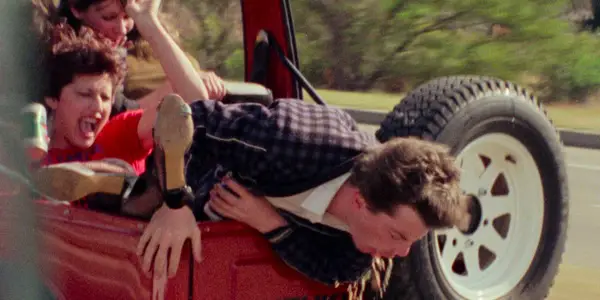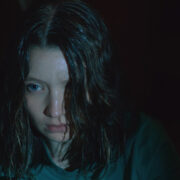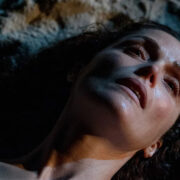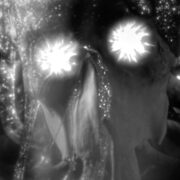“If I Can’t Be Free, I Can Be Cheap”: GOING DOWN Is a Riotous Slice of Aussie Punk Life

Payton McCarty-Simas is a freelance writer and artist based in…
There are certain films that capture a time and place so vividly that they feel more like fragments of the past–– or dirty handprints on a bathroom mirror–– than trips to the theater. So it is with Going Down (1982), Hayden Keenan’s self-distributed Australian cult classic (newly restored in 4K by Muscle Distribution), which delights in spreading graffiti and pixie dust all over Sydney’s post-punk scene. Told over twenty-four debauched hours, the film reels its way through the lives of four roommates, the middle-class Karli (Tracy Mann, Hard Knocks), the alcoholic Jane (Vera Plevnik, Monkey Grip), the unemployed Jackie (Julie Barry, Hell Hole) and the square Ellen (Moira MacLaine-Cross, Tender Hooks), as well as their mad cavalcade of frenemies, lovers, and drug dealers.

These dynamic and marvelously messy women are drawn together by circumstance and a shared passion for excesses of all kinds––among them amyl nitrate, cocaine, and an irresistibly well-hung punk named Shadow (Ian Gilmour)–– only to be strung out by distrust when Karli, who’s plane for NYC leaves in the morning, finds her starting-out money has been stolen during the going away festivities. Girls look for work wherever they can, get ready for parties, search each other’s faces for secrets. The film pulses with life, humor, and barely-sublimated melancholy, driven along by a sweet eye for whimsy, a bleak, razor-sharp wit, and a thrashing soundtrack featuring a jumble of live performances by big names in Australian post-punk and new wave, among them Pel Mel, Dynamic Hepnotics, and Julie Cook. It blends collage-style visuals with Shakespeare, short skirts with Superman, beer with liquor, sex with danger. In a word, it’s glamorous; but whenever things start looking too cool, Keenan hits us with a broken bottle, a police bust, or a cartoonishly virtuosic torrent of puke–– just to keep us, and the characters, honest.
The film, which has been described as a “feral” coming-of-age tale, deftly balances a warm affection for its quirky, druggy women-on-the-verge (think punk chick flicks like Smithereens or Times Square) with a sharp undercurrent of genuine fear for their futures more akin to darker explorations of this scene like Suburbia or Sid and Nancy. That the balancing act feels easy, never leaning too far into the surreally whimsical or the maudlin (while cheerfully teetering on the edge of both) and avoiding the all-too-common air of predictability that can come with this kind of storytelling is impressive. The whole thing feels like it’s barely holding together, vibrating with jittery uppers-and-downers tension. Ellen’s new boyfriend Greg (David Argue, Gallipoli) is a Kamikaze Buster Keaton in Elvis Costello suspenders, seemingly glued to his roller skates, which he uses to hurtle his way down escalators, through shopping malls, and onto cartoon beaches with disastrous calm, bleeding freely; two drug addled buddies steal a kid’s panda bear stuffy to score cough syrup “for sick little ones at home,” only for the kids to try and blackmail them in turn; a man casually aims a shotgun at a baby while a partygirl buys heroin on credit. Sickly laughs and smiles all around, and we mostly laugh too. It’s like if What’s Up Doc? were about the kids from Saturday Night Fever.

This feat of equilibrium is likely a product of the creators’ closeness to the material. Inspired by MacLaine-Cross and Barry’s real-life experiences in this milieu (the script was co-written by the pair with the help of Melissa Woods), its meditations on self-destruction would prove prescient. Co-star Vera Plevnik would die in a car crash at just twenty-six, a full year-and-a-half before the film premiered. Plevnik’s performance as Jane, who’s defined by her increasing desperation–– for work, for friends, for a good time–– is arguably the stand-out of the film, and her death, as Mark Sawyer pointed out in The Sydney Morning Herald, adds a poignancy to some of the film’s more abstract, collaged scenes of coming-of-age anxiety. Another notable performance comes from scene-stealing playwright and actor Esben Storm, who embodies a lean-addicted would-be writer (of “black comedies” and “trendy detective novels,” two of the film’s main generic influences) with a dead-eyed, languid charm that’s equal parts off-putting, endearing, and sad.

In the end, this is the kind of movie that most viewers will like or dislike depending on their affinity for the genre as a whole, but its unexpected open-heartedness is its greatest virtue. As the women’s night progresses and things begin to spin out of control, tensions rise to the surface that no drug can blot out; but this is a girl’s night, too, and we can count on love to conquer–– if not all, then at least some. The film is filled with the kinds of stoned, earnest conversations about life and its small victories that anyone who’s had them will find sweetly familiar. The friends comfort and jab each other with platitudes: “God loves a working girl;” “If we’re fit to survive we’ll survive;” “Who knows what happened last night;” “If I can’t be free, I can be cheap.” At least for the night, that’s enough. Cheers.
Going Down will begin its first theatrical run in the US on May 9th at BAM in NYC, followed by screenings in other major cities.
Visit Muscle Distribution’s website for more information.
Does content like this matter to you?
Become a Member and support film journalism. Unlock access to all of Film Inquiry`s great articles. Join a community of like-minded readers who are passionate about cinema - get access to our private members Network, give back to independent filmmakers, and more.
Payton McCarty-Simas is a freelance writer and artist based in New York City. They grew up in Massachusetts devouring Stephen King novels, Edgar Allan Poe stories, and Scooby Doo on VHS. Payton holds a masters degree in film and media studies from Columbia University and her work focuses on horror film, psychedelia, and the occult in particular. Their first book, One Step Short of Crazy: National Treasure and the Landscape of American Conspiracy Culture, is due for release in November.













